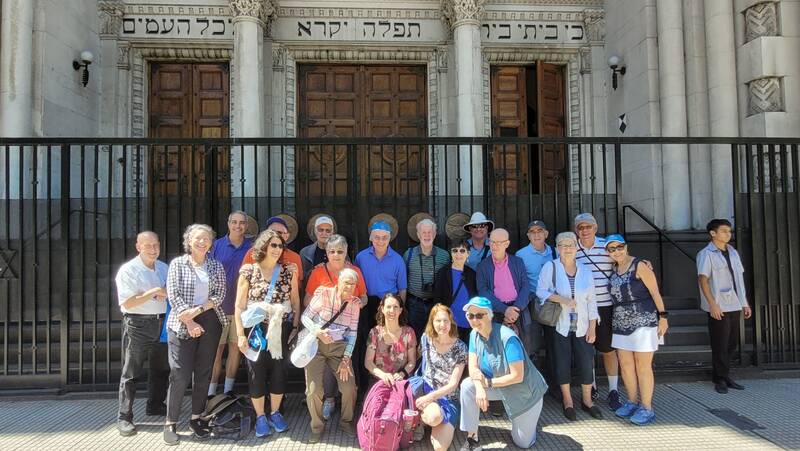- Worship
- Education
- Lifecycle
- Events & Programs
- About Us
- Join Us
- Donate
Trip to Argentina Blog 2024
B'nai israel congregation trip to argentina
March 5 (Day 1)
Bienvenido a Argentina! Welcome to Argentina!
 Our group is so excited to have finally landed in Buenos Aires. With a delayed flight from Dulles, a long layover in Atlanta, and busy immigration and customs lines in Buenos Aires, the door-to-door travel time turned out to be just under 24 hours. But we arrived at our hotel a little before noon and were ready for an exciting day of touring. After a lovely opening lunch—the caramel cheesecake with dolce la leche was sinful but worth it—we embarked on a tour of the old city of Buenos Aires. In the San Telmo La Boca neighborhoods we saw some of the houses where Spaniards lived during colonial times. When immigrants arrived, many of the more-established Spaniards moved to more elite neighborhoods in other parts of the city (a phenomenon that may sound familiar to Americans) and giant homes were converted into multi-family housing. Many of these older houses have been converted to markets.
Our group is so excited to have finally landed in Buenos Aires. With a delayed flight from Dulles, a long layover in Atlanta, and busy immigration and customs lines in Buenos Aires, the door-to-door travel time turned out to be just under 24 hours. But we arrived at our hotel a little before noon and were ready for an exciting day of touring. After a lovely opening lunch—the caramel cheesecake with dolce la leche was sinful but worth it—we embarked on a tour of the old city of Buenos Aires. In the San Telmo La Boca neighborhoods we saw some of the houses where Spaniards lived during colonial times. When immigrants arrived, many of the more-established Spaniards moved to more elite neighborhoods in other parts of the city (a phenomenon that may sound familiar to Americans) and giant homes were converted into multi-family housing. Many of these older houses have been converted to markets.
 We toured a traditional market in SanTelmo—what was originally a place for selling fruits, meats, and vegetables to families has been converted into an area for pubs, restaurants, and shops. We enjoyed some street tango and a beautiful late summer day before boarding the bus and traveling to LaBoca
We toured a traditional market in SanTelmo—what was originally a place for selling fruits, meats, and vegetables to families has been converted into an area for pubs, restaurants, and shops. We enjoyed some street tango and a beautiful late summer day before boarding the bus and traveling to LaBoca neighborhood. There we walked around the colorful Caminito neighborhood with its trendy bars and shops.
neighborhood. There we walked around the colorful Caminito neighborhood with its trendy bars and shops.
After freshening up in our beautiful hotel, we traveled a few blocks for a beautiful opening dinner at Bet Jabad (In Spanish transliteration, the "J" makes the "ח" sound we usually transliterate as "ch"). Dinner was lively, but when it ended we knew it was time for bed. This was a very long day!
Tomorrow, we look forward to touring the Jewish heart of this beautiful city.
March 6 (Day 2)
Today was an incredibly interesting day, as we uncovered the history of Jewish settlement in Buenos Aires. We learned that Argentina means Land of Silver (Argentum; that's why AG is the symbol for silver on the periodic table!). The first Jews came to this Catholic country in the end of the 15th century to escape the Inquisition. We visited the Church of St. Assisi, founder of the Franciscan Order. In the 16th-century, Franciscan monks protected Jews from the Dominicans who were controlling the Inquisition. Why did these Franciscans want to protect Jews? Because Jews were helping to create new routes to smuggle silver out of Buenos Aires in a way that avoided unjust taxes from certain colonial powers.
We also visited the Metropolitan Cathedral of Buenos Aires, one of the city's most important Catholic churches, located on the main city square, a few hundred feet away from the Pink House (the place where the Argentine president works; I joked it's what the White House might have looks like if it was built in South Florida!). The sculpture on the church façade depicts the reconciliation between Joseph and his brothers from Genesis. It was placed in 1860, the year the civil war between Buenos Aires and the provinces ended.

Description automatically generated(this is a picture of the Holocaust memorial. It begins with the book of Esther at the top because Haman was the first person in history to single out the Jews simply because they were Jewish.)

And the beef. Oh the beef. We ate well today. It was probably too much, but our Jewish mothers would have been satisfied, I am sure.
Can't wait to see what's coming tomorrow!
A sign from the lobby at the Libertad synagogue. We don't have to understand Spanish to know what it means. #BringThemHomeNow. Am Yisrael Chai!
March 7 (Day 3)
Special Guest Blogger: Peggy Pearlstein
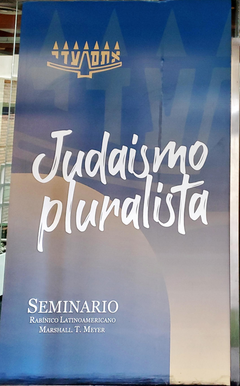 Our tour this morning continued the wonderful blend of Jewish and Argentine history here in Buenos Aires that we experienced our first two days. This morning we traveled out to the beautiful suburb of Belgrano to the Seminario Rabinico Latinoamericano. An affiliate of the Jewish Theological Seminary in New York City, the Seminario was founded in 1962 by Rabbi Marshall T. Meyer. While the main purpose of the Seminario is to ordain rabbis to serve in Jewish communities in Latin America, it is also a religious, academic, and cultural center. Rabbi Meyer created a branch of Camp Ramah, as well, which is the camping arm of Conservative Judaism in the United States and Israel.
Our tour this morning continued the wonderful blend of Jewish and Argentine history here in Buenos Aires that we experienced our first two days. This morning we traveled out to the beautiful suburb of Belgrano to the Seminario Rabinico Latinoamericano. An affiliate of the Jewish Theological Seminary in New York City, the Seminario was founded in 1962 by Rabbi Marshall T. Meyer. While the main purpose of the Seminario is to ordain rabbis to serve in Jewish communities in Latin America, it is also a religious, academic, and cultural center. Rabbi Meyer created a branch of Camp Ramah, as well, which is the camping arm of Conservative Judaism in the United States and Israel.
At the Seminario, we were greeted by the dean of students, Rabbi Ernesto Yattah. This was very special because Rabbi Ernesto was familiar to our group. Yesterday, he was our amazing guide to unpacking the history of the Jews of Argentina; today he was one of the foremost leaders of our Conservative movement in Latin America. He showed off the amazing educational infrastructure that has been created here and was also incredibly honest about the challenges our movement faces in Latin America. We often tell ourselves that the "competition" comes from the Reform and Conservative; there is some truth to this, but the real "competition" comes from secularization and assimilation, two challenges all the movements face together.
For me, the visit to the Seminario was also personal. I met with Rita Saccal, who was both my professional colleague and my friend. She served as the librarian at the Seminario for 25 years until her recent retirement. I worked at the Library of Congress for 31 years, all of them in the Hebraic Section. Rita and I saw each other in the United States at the annual conference of the Association of Jewish librarians. How wonderful to see her at the Seminario in Buenos Aires!
Guest Blogger: Rob Loewy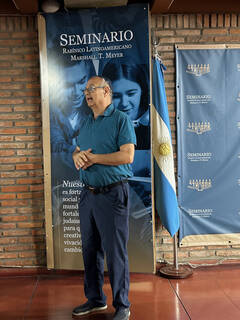
Following another abundant breakfast at our beautiful Palladio Hotel, we boarded the bus for the Seminario Rabínico Latinoamericano. Founded in 1962, the seminary ordains more than a dozen conservative rabbis each year, including some gay and transgender individuals. Rabbi Ernesto Yattah, Dean of the Seminary, conducted the tour. The facility shows every day of its 62-year age and operates on a shoestring budget.
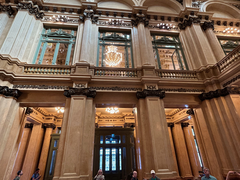 We continued on to the circa 1908 spectacular Teatro Colon (Colon Theater), Buenos Aires' Opera House, which took 20 years to complete. With a capacity of 3,078 (600 of them standing), it is said to have among the best acoustics in the world. Opulent and luxurious, with beautiful architecture and art and interior stone from Italy, Spain, and Portugal. We wondered if anyone could afford to build it today.
We continued on to the circa 1908 spectacular Teatro Colon (Colon Theater), Buenos Aires' Opera House, which took 20 years to complete. With a capacity of 3,078 (600 of them standing), it is said to have among the best acoustics in the world. Opulent and luxurious, with beautiful architecture and art and interior stone from Italy, Spain, and Portugal. We wondered if anyone could afford to build it today.
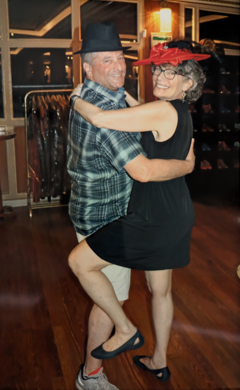 Following an afternoon at leisure, we had a group Tango lesson (great fun and humbling for the grace and rhythm-challenged!), along with a group of San Diego high schoolers. Dinner and a colorful, high-energy Tango show capped off the day.
Following an afternoon at leisure, we had a group Tango lesson (great fun and humbling for the grace and rhythm-challenged!), along with a group of San Diego high schoolers. Dinner and a colorful, high-energy Tango show capped off the day.
Viva Buenos Aires!
March 8 (Day 4)
Guest Blogger: Vickie Abrutyn
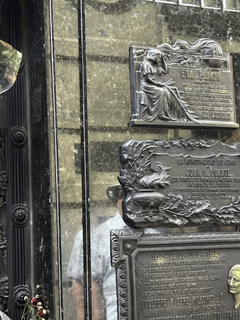 Luggage down and on the bus
Luggage down and on the bus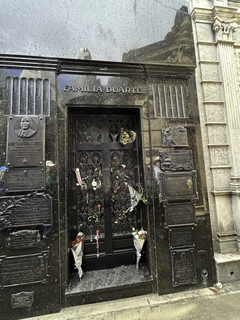 to head off for a morning of sightseeing before going to our Shabbat hotel. We began by visiting Recoleta Cemetery, one of the most famous in the word. Built in 1922, it has 4822 mausoleums 22 of them capable of holding up to 30 family members (apparently, wives are not considered family members!) The families own the burial sites in perpetuity and many are deserted and in disrepair because descendants cannot be found. Eva Perone is buried here; her mausoleum is the most visited in the cemetery. There is only one Jew buried here, together with his non-Jewish wife.
to head off for a morning of sightseeing before going to our Shabbat hotel. We began by visiting Recoleta Cemetery, one of the most famous in the word. Built in 1922, it has 4822 mausoleums 22 of them capable of holding up to 30 family members (apparently, wives are not considered family members!) The families own the burial sites in perpetuity and many are deserted and in disrepair because descendants cannot be found. Eva Perone is buried here; her mausoleum is the most visited in the cemetery. There is only one Jew buried here, together with his non-Jewish wife. 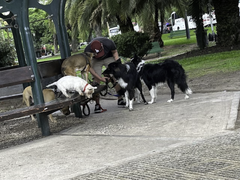
We made a short stop at The National Museum of Art where we viewed a collection of old masters from Argentina and all over the world. Of course, we found the bathrooms as well! There are dog walkers all over the city and many of the parks have dog parks in them.
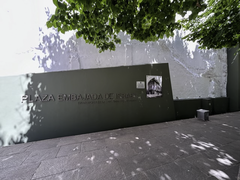
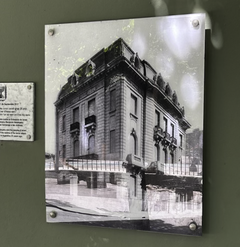 Before heading to the hotel, we made a stop at a memorial where the Israeli Embassy was bombed. Again, it is assumed that Hamas or another Iranian-backed terrorist group is responsible, but no one has been brought to justice for this crime. Today, the embassy is located in a nondescript but more secure office building in the center of town.
Before heading to the hotel, we made a stop at a memorial where the Israeli Embassy was bombed. Again, it is assumed that Hamas or another Iranian-backed terrorist group is responsible, but no one has been brought to justice for this crime. Today, the embassy is located in a nondescript but more secure office building in the center of town.
Another terrific lunch before heading to the hotel to be followed by Shabbat Services with dinner to follow with the Jewish Community of Amijai.
Cannot say enough about the vibrant community and their spiritual leader. We were part 700 congregants who sang and worshiped. Afterwards they hosted us for Shabbat dinner. Other than a driving rain storm as we walked back to the hotel it was a most wonderful day.
March 10 (day 6)
Reflections on our Shabbat in Buenos Aires
We are tourists in Buenos Aires, but on Shabbat we were among family. On Friday evening, we visited Congregation Amijai for a spirited, musical Shabbat service. It was very different from B'nai Israel, which means some in our group loved it and others … not as much. But we were all moved by the hospitality.
Rabbi Alejandro Avruj delivered a 15-minute sermon in Spanish, which none of us understood. (It turns out that he was speaking about the march that took place in Buenos Aires for National Women's Day; the march organizers decried the war in Gaza—which they called a genocide— but, of course, they didn't mention anything about the Jewish women who were raped, kidnapped and killed by Hamas. It was a very appropriate message and you could tell the congregation of more than 600 was moved).
Some things didn't need translation. When the congregation stood up and applauded a couple from the congregation who had made Aliyah, served in the war, and came back to visit … we understood what was happening and were moved. Same thing when the rabbi welcomed our group by name—and singled me out—and the congregation applauded. Even in Spanish, we understood the value of hakhnasat orhim (welcoming guests). It felt like we were living out an old camp song—"Wherever You Go, There's Always Someone Jewish!"
After the service, we were hosted for Shabbat dinner by the family of B'nai Israel member Mica Carmio. Mica's parents—Susanna and José—were among the 8 families who founded Congregation Amijai 30 years ago. We were also joined by Mica's sister, Jennifer, and her two daughters. The food was excellent and the company was even better. Rabbi Avruj also came to welcome our group and speak a little bit about the community. We heard how the congregation was founded by a small group who had been part of Congregation Bet El, the most established of the Conservative congregations, and were looking for something vibrant and new. Except for the rainstorm on the walk home—if I had a different theology, I would suggest that we just didn't pray hard enough! – the evening was a delight.
The next morning, we visited Congregation Bet El, and again we were welcomed with open arms. In Argentina, Friday night is the popular service and Saturday morning is much smaller; so our group comprised a significant part of the minyan, The service here was quite similar to what we are used to at B'nai Israel—aside from the musical accompaniment, which is taken for granted in every non-Orthodox synagogue in Argentina. After the service, we were hosted for lunch by Rabbi Yarden Robert, his lovely family, and members of the Bet El community.
We heard more about Rabbi Marshall Meyer—a classmate of Rabbi Matthew Simon z"l, the founding rabi of the synagogue, and the most important organizer of Latin American Jewish life in the second half of the 20th-century. When Marshall Meyer graduated rabbinical school in 1959, he was sent to Argentina by Rabbi Abraham Joshua Heschel and asked to organize the community. At that time, there were many Jews living in Buenos Aires, but they were largely secular and served by European-trained Orthodox rabbis who did not necessarily understand the intricacies of Latin America. Rabbi Meyer founded the Seminario Rabbinica to train rabbis and Jewish leaders and created the infrastructure for religious life here. Most everything that exists religiously today is built upon Rabbi Meyer's legacy and the infrastructure he built. I found it ironic that Bet El was founded as an alternative to old-school, traditional Judaism and, 30-years-later, Amijai was founded because Bet El felt to "old-school."
During our lunch, we also discussed the challenges of sustaining community at Bet El. Every community is different, but the basic challenges—secularization and assimilation—feel familiar everywhere. The Jewish day school system boasts 20,000 students, but this is still the minority. We met madrichim (advisors) from the synagogue's youth group, which hosts hundreds of children (ages 2 to 18) for education and community building every week. Each of the synagogues we visited host 70-80 b'nai mitzvah each year; those students are educated for about a year in preparation for the big day.
The community is impressive; but as Jews, we live to worry about the future. That, too, felt incredibly familiar.
March 12 (day 8)
Guest Blogger: Dr. Seymour Hepner
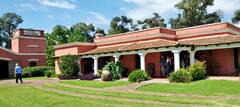 On Monday we drove 90 minutes, stopping at a nice souvenir store. Our destination was San Susana, an estancia (ranch). It was a beautifully maintained 1300 hector property, founded in the late 19th century by an Irish family. A gaucho (cowboy) gave us a tour of the original main house which contained all of the furniture and clothing. Today the estancia raises horses, cattle, and grows agricultural crops.
On Monday we drove 90 minutes, stopping at a nice souvenir store. Our destination was San Susana, an estancia (ranch). It was a beautifully maintained 1300 hector property, founded in the late 19th century by an Irish family. A gaucho (cowboy) gave us a tour of the original main house which contained all of the furniture and clothing. Today the estancia raises horses, cattle, and grows agricultural crops.
A bumpy horse drawn carriage ride topped off the morning.
Lunch was a kosher barbecue with wine. It was followed by joyous entertainment - music, tango dancing, and an exhibition of bolas twirling.
The ride back to Buenos Aires was in the midst of a powerful rainstorm.
Our last dinner together was at the Alvear Icon Hotel, a magnificent venue with several kosher restaurants. We dined on bruschetta with salmon, ceviche, pasta or fish, and exquisite desserts.
After a long tiring day we retired as soon as possible to allow those going on to Iguazu Falls to get an early start the next day.
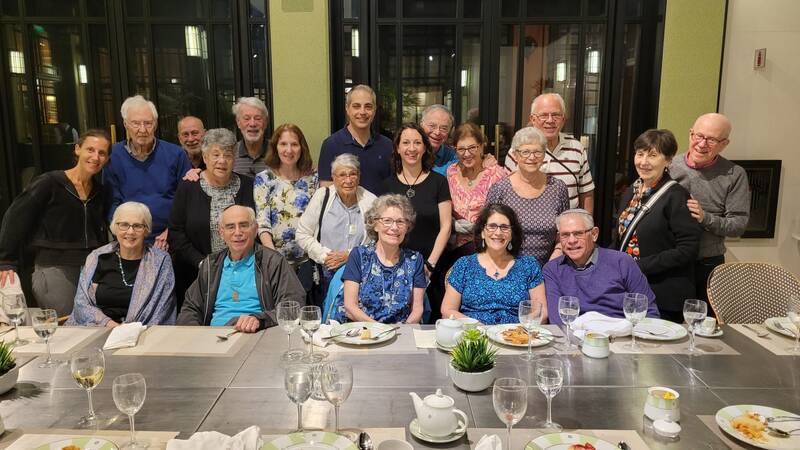
March 13 (day 9)
Guest Blogger: Rob Loewy
We’ve had fantastic weather in Buenos Aires until yesterday afternoon, when during our lunch at a Gaucho ranch the skies opened up with violent thunderstorms. Rain and thunderstorms continued overnight, and the eight of us continuing on to Iguazu Falls set zero-dark-thirty alarms this morning for our 90-minute flight.
There was an obvious ground stop at Jorge Newberry airport (BA’s downtown airport— international flights are at a much larger airport south of the city), but nothing was announced and information was impossible to come by.
Our 10am flight showed “on-time” as late as 1pm, but no gate was assigned so we couldn’t even know if our aircraft was on the ground. In the end it was a long, long day in a crowded airport with not nearly enough seating. Some of walked the length of the concourse again and again, others sat on the terrazzo floor, but the main occupation was waiting for something - anything - to show up on the flight status board.
Eventually we boarded for the falls, arriving here at 5:00 PM, where we were met by Gil, our effusive, tzitzit-wearing, brown-complected host from Northern Brazil who speaks 5 or 6 languages and is of Moroccan descent.
It is hot hot hot here, especially when compared to a breezy high 70s/low 80s in BA.
We’re in another beautiful hotel, set in the woods/trees, with expansive grounds, two pools, and a casino "...open until 3:00 AM..." We assured them we wouldn't be awake to test the closing time.
We checked in, cleaned up, and headed to dinner across the border in Brazil (collecting a Brazil stamp in our passports), where we’ll return tomorrow as we visit both sides (Argentina and Brazil) of the falls on Wednesday before heading home late Thursday night.
The chronicler for Wednesday will have a far easier time describing a far more interesting day!
Best to everyone in Rockville.
Sat, April 27 2024
19 Nisan 5784
Livestream
Shabbat Services
Friday at 6:15 PM
Saturday at 9:00 AM
the latest
announcements
Happy Passover from your B'nai Israel Family
We have programming and services throughout the holiday for all ages. Please join us.
Annual Meeting and Hineini Meeting "Thank You" Event on May 20
We are excited to gather our community. Please join for our Annual Meeting and Hineini "Thank You" Event.
Lessans Talmud Torah registration for 2024–2025 is open!
Registering early just got sweeter. Learn more about our program and registration raffle.
B'nai Israel Schilit Nursery School 2024-2025 Program Registration is now OPEN
Our award-winning school can't wait to meet your family. Very limited spaces remain. Learn more. View the beauty of our nursery school ART SHOW.
B'nai Israel First Synagogue in North America to Install RightHear, supporting those who are blind or low vision.
Read our press release here.
NEW Resource: Fighting Antisemitism
Raise Awareness, Educate, and Act to stop antisemitism. Learn more.
Our 2023-2024 Hineini Annual Campaign is Under Way
B'nai Israel is "Here for YOU". Support us today.
Join Our Shabbat Morning Livestream
Click here to access.
Explore Our Exciting Adult Education Offerings
Learn more here.
weekday services
Sunday | 9:00 AM & 8:00 PM
Monday–Thursday | 7:15 AM & 8:00 PM
Friday | 7:15 AM
*Service times vary on holidays.
Click here for access information.
shabbat services
Friday | 6:15 PM (7:00 PM during Summer)
Saturday | 9:00 AM & 12:30 PM (Minha)
Click here for access information.
inclement weather policy
Click here for information.


